Early ripening hybrid tomato "Aurora", created to obtain a bountiful harvest in the greenhouse and in the garden
Tomato Aurora is a relatively new hybrid that appeared as a result of the development of Russian breeders. Its excellent adaptation to cold weather, which does not affect fruiting, was immediately appreciated by residents of cold regions. Even in areas with short and cool summers, farmers reap a double harvest. Ripe vegetables have excellent taste and high vitamin content, which is beneficial for enhancing immunity.
Hybrid care is so simple that many newcomers to summer cottages opt for this particular variety.
The content of the article
Feature and Description
Aurora is a precocious hybrid that is of particular interest to residents of the northwest regions. The name of the culture personifies the ancient Roman goddess of the dawn, symbolizing the early ripening of fruits.
Distinctive features
The type is determinant, the height is 65-75 cm. The first brush is tied after 6-7 leaves, the subsequent ones every 2 leaves. The foliage is moderate, the leaves are elongated, bright green.
 The ripening period is ultra-early - 90 days pass from the moment of sowing to full ripening.
The ripening period is ultra-early - 90 days pass from the moment of sowing to full ripening.
The yield is high - up to 4.5 kg are harvested from 1 seedling, provided that 7-8 plants are planted per 1 sq. m.
The hybrid is highly resistant to diseases of the nightshade family, especially late blight.
Recommended for cultivation in the open field and in greenhouse conditions. Well adapted to changing weather conditions.
The culture does not need a garter of undersized bushes. However, next to each tomato, vertical supports are installed, without which the plant can do without during the ripening period.
The bushes are taken care of without fail, the quantitative indicator of fruiting depends on this procedure. Stealing is the partial removal of unnecessary shoots.
reference... After the first harvest, it is possible to harvest ripe fruits a second time. To do this, do not remove the late lateral shoots, which the culture discards after the first collection of vegetables.
Fruit characteristics
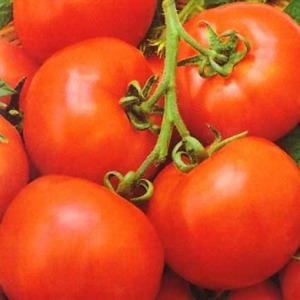
The average weight of one fruit is 110-140 g. The shape is round, the color is bright red. The taste is excellent, sweet with barely noticeable sourness. The pulp is juicy, the skin is not too dense, but it is not subject to cracking.
Ripe vegetables are stored for a long time and can withstand transportation over long distances without losing their presentation. For these reasons, entrepreneurs are considering this tomato crop commercially.
The photo shows the Aurora tomatoes.
How to grow seedlings
Sowing seeds for seedlings begins 2 months before planting in the ground. Previously, the seeds are thoroughly disinfected and processed in growth stimulants.
Seed preparation
For several minutes, the seed is kept on the battery, thereby drying well. Then carefully inspect for visible damage. Grains suitable for sowing should be light and free from distortion. Then they are placed in saline solution for 10 minutes.
Seeds that have floated to the surface are not suitable for sowing. Next, the inoculum is disinfected in a weak solution potassium permanganate 20 minutes. After disinfection, they are washed in running water and dried.
To improve germination, the grains are soaked in a growth stimulator for 12 hours. Swollen seeds can be sown in the ground.
reference... As a growth stimulator, you can use melt water, in which the planting material is also placed for 12 hours.
Capacity and soil
The soil is prepared from a mixture of garden soil, peat and sand, taken in equal proportions. The resulting soil mixture is disinfected with a hot solution of dark-colored potassium permanganate or calcined in the oven for 15 minutes at a temperature of 60 ° C. The cooled soil is laid out in planting containers, having previously made drainage holes for excess moisture to drain into them.
reference... Peat is an essential component for the growth and development of any crop. But in its pure form, it is not suitable for growing seedlings.
They are planted in a common wooden box or in an individual container: plastic cups, paper honeycombs, peat pots. Before sowing, the prepared container is disinfected to destroy pathogenic microbes.
Sowing
Sowing seeds is carried out to a depth of 2 cm, after slightly moistening the soil with warm, settled water. After sowing, the containers are covered with foil to create a greenhouse effect and left in a bright and warm room at a temperature of at least 23 ° C.
Periodically, the film is removed for ventilation and the soil is moistened as needed with warm water using a spray bottle.
reference... Seeds are sown 3 cm apart, otherwise the seedlings will be pulled up.
Seedling care
When the first shoots appear, the film is removed, and the containers are rearranged to a more illuminated place, on the windowsill. Daylight hours should be at least 14 hours. If there is a lack of natural light, they are supplemented with phytolamps.
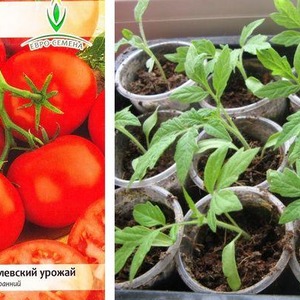
Watered as the top layer of the soil dries up, with warm, settled water using a shallow watering can along the edge of the nursery. After watering, surface loosening is carried out without touching the young roots.
When 2 true leaves appear, the seedlings dive, seating them in separate containers. If the seeds were sown in separate cups, picking is not required. When picking, only healthy and strong shoots are left, and the weak are disposed of.
2 weeks before planting in the ground, the seedlings begin to harden. The hardening procedure is reduced to holding the seedlings outside for 40-50 minutes in the daytime at a temperature of 15 ° C. This interval is gradually increased to 12 hours. The night temperature in the room where the seedlings are introduced is reduced to 10 ° C.
How to grow tomatoes
After 2 months, the seedlings are ready for transplantation. At this time, there are 6-7 true leaves on the sprouts and fully formed young roots.
Landing
The soil is prepared in the fall. The tomato does not like high acidity, so if the soil is highly acidic, it is neutralized with lime in the amount of 0.9 g per 1 sq. m. The soil is dug up and mineral fertilizers are applied.
In the spring, the soil is dug up again and organic matter and superphosphate are introduced. Seedlings are planted in shallow holes, on the bottom of which a little ash is previously placed. After transplanting, the holes are watered, loosened and left unattended for 1 week. During this time, young bushes finally adapt to new conditions.
reference... Tomatoes should not be planted in soil where potatoes and peppers were previously grown. After these crops, the soil is severely depleted, and tomatoes require a large amount of nutrients.
Planting pattern: 35 cm - distance between plants, 40 cm - between rows. For 1 sq. m place no more than 8 seedlings. It is best to replant after sunset or on a cloudy day.
Further care of the Aurora tomato
Regular watering installed no more than 2 times a week. Watered with warm, settled water, under the root, without falling on the leaves. The best time to water is evening or early morning. After each watering, the soil is loosened, removing all weeds with roots.
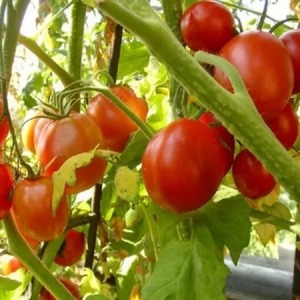 For long-term moisture retention of the garden mulch straw or peat. This method is especially important on hot and dry days., since the tomato does not like it when the top layer of the soil is covered with a dried out crust. But it is also impossible to overmoisten the beds. In this case, the risk of fungal diseases increases.
For long-term moisture retention of the garden mulch straw or peat. This method is especially important on hot and dry days., since the tomato does not like it when the top layer of the soil is covered with a dried out crust. But it is also impossible to overmoisten the beds. In this case, the risk of fungal diseases increases.
The first top dressing in the form of mineral fertilizers are applied two weeks after transplantation. The complex of mineral fertilizers can be replaced with organic matter, for example, bird droppings or mullein infusion in a ratio of 1:15. After a week, the same feeding can be repeated.
The second time the crop is fed during flowering. A complex of mineral fertilizers or organic matter is introduced. The need for a third feeding arises during fruiting. In addition to organic, potash fertilizers are added to the solution, which accelerate the ripening of fruits.
Advice... If the bushes initially grow poorly, you can feed them with nitrogen fertilizers. They not only stimulate plant growth, but also contribute to the growth of green mass.
Features in care and possible difficulties
Low-growing bushes do not require an obligatory garter, a powerful stem is quite capable of withstanding fruit-bearing branches. But the branches themselves are spreading, and therefore vertical supports are installed under them, so that when ripe, the weight of the fruits does not bend them to the ground. When in contact with damp beds, vegetables may rot.
The hybrid is partially transplanted, removing all shoots under the lower leaves and preventing thickening of the plants. The hybrid shows the best quantitative indicator when formed in 1 or 2 stems.
After the first harvest, the plant throws out lateral shoots that do not need to be removed. Soon they become fruitful branches and give birth a second time.
Diseases and pests
The hybrid has proven to be highly resistant to many diseases affecting the nightshade family. He does not suffer from phytophthora either. But still, do not forget about preventive measures, which include moderate watering, systematic loosening, removal of weeds and regular ventilation of closed structures, if the culture is planted in a greenhouse.
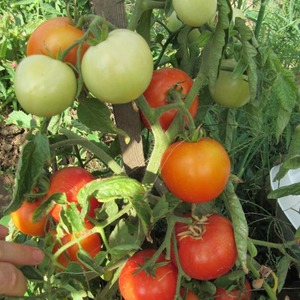 For the development of fungal spores, high humidity and high air temperatures are required. If the beds are not waterlogged, the risk of disease is dramatically reduced.
For the development of fungal spores, high humidity and high air temperatures are required. If the beds are not waterlogged, the risk of disease is dramatically reduced.
In the open field from insect pests, whitefly, Colorado potato beetle, slugs and aphid.
The most important preventive measure in the fight against insects is regular inspection of the bushes. for pests... Removing the larvae on time will prevent the parasites from spreading and causing further harm.
In the fight against the Colorado potato beetle, mustard bushes planted next to the tomatoes help, which frighten off the beetle with an unpleasant smell. In case of large congestion, the drug "Prestige" is used.
A soap solution will help get rid of aphids and slugs. The stems and leaves of affected plants are treated with it. Pheromone traps, which are installed near tomatoes, will save the whitefly. Their scent attracts the butterfly, and it flies into the trap.
The nuances of breeding in open and protected ground
Desirable precursors for the tomato crop are cabbage, legumes and cucumbers. After them, the earth is saturated with nitrogen, which is necessary for the life of tomatoes. You can plant a tomato again in the same place by first adding organic fertilizers to the ground. If the crop is planted in protected soil, the topsoil must be replaced and disinfected. Thus, pathogenic flora is destroyed, which significantly reduces the risk of diseases.
The lower leaves of plants must be removed so that they do not come into contact with damp beds, as this can lead to the spread of fungal spores.
It is not necessary to thicken the plantings, otherwise the plants will interfere with each other from receiving the required amount of heat and light.In addition, such conditions increase the risk of the spread of pests that are difficult to detect in time.
Harvesting and application of the crop
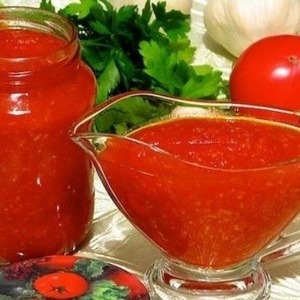 Ripe vegetables are harvested from the beginning of summer, even in cold regions. Tomatoes ripen together, with whole brushes, which greatly simplifies the collection.
Ripe vegetables are harvested from the beginning of summer, even in cold regions. Tomatoes ripen together, with whole brushes, which greatly simplifies the collection.
The purpose in cooking is universal. Tomatoes are used in a variety of dishes: salads, snacks, hot and vegetable dishes, baked with meat.
They make excellent juices, puree, adjika, lecho, pasta, ketchup.
Also, vegetables are used for whole-fruit canning, pickles and pickles.
Advantages and disadvantages of the variety
Let's start the review of the section with the positive qualities of the hybrid:
- high-yielding species;
- ultra-early ripening;
- immunity to many diseases;
- good adaptation to weather conditions;
- the possibility of obtaining a double harvest;
- unpretentious care;
- no mandatory garter required;
- great fruit taste;
- amicable maturation;
- marketable condition;
- the possibility of breeding for sale;
- long-term storage;
- long transportation;
- versatility in cooking.
The disadvantages can only be attributed to pinching the culture, but this procedure does not require much time and effort.
Farmers reviews
Reviews of gardeners confirm the reliability of the culture, regardless of the region of growth. Even in cold areas, it will give a high harvest.
Antonina, Kerch: «I was very pleased with the early ripening. There were many and rather large inflorescences. Used fruits for preservation and in salads. I recommend it to everyone, because I myself am satisfied. A truly unique hybrid. "
Semyon, Bryansk: “This hybrid is characterized by resistance to weather conditions, so I know for sure that any cold snap will not harm it. It is very convenient to care for undersized bushes. It is possible to provide watering at the root, and thorough loosening of the soil. There are a lot of ripe vegetables, very tasty, enough for winter harvesting. "
Conclusion
Tomato Aurora f1 has established itself as a high-yielding, well-adapted to weather whims, unpretentious in care and disease-resistant hybrid. For entrepreneurs, this tomato is a stable source of income, and for summer residents it is a favorite tomato crop that will not fail under any circumstances and will always give a rich harvest of excellent quality and taste even in regions with a short and cold summer.